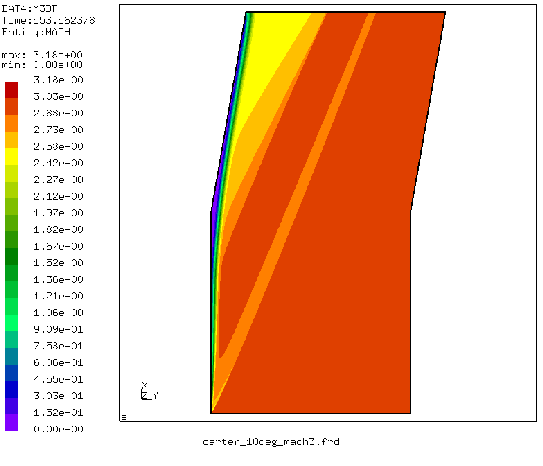 |
Note: CFD-calculations have been deactivated in version 2.7 due to unsatisfactory results. A new approach is being pursued.
This benchmark example is described in [14]. The input deck for the
CalculiX computation is called carter_10deg_mach3.inp and can be found in the
fluid test example suite. The flow is entering at Mach 3 parallel to a plate
of length 16.8 after which a corner of
![]() arises. The Reynolds
number based on a unit length is 1000., which yields for a unit velocity a
dynamic viscosity coefficient
arises. The Reynolds
number based on a unit length is 1000., which yields for a unit velocity a
dynamic viscosity coefficient
![]() . No units are specified: the user
can choose appropriate consistent units. Choosing
. No units are specified: the user
can choose appropriate consistent units. Choosing ![]() and
and
![]() leads to a specific gas constant
leads to a specific gas constant ![]() . The selected Mach number leads to
an inlet temperature of
. The selected Mach number leads to
an inlet temperature of ![]() . The ideal gas law yields a static inlet
pressure of
. The ideal gas law yields a static inlet
pressure of ![]() (assuming an unit inlet density). The wall is assumed to be isothermal at a total
temperature of
(assuming an unit inlet density). The wall is assumed to be isothermal at a total
temperature of ![]() . Finally, the assumed Prandl number (Pr=
. Finally, the assumed Prandl number (Pr=
![]() ) of 0.72 leads to
a conduction coefficient of 0.00139.
) of 0.72 leads to
a conduction coefficient of 0.00139.
A very fine mesh with about 425,000 nodes was generated, gradually finer towards
the wall (![]() for the
closest node near the wall at L=1 from
the inlet). The Mach number is shown in Figure 37. The shock wave
emanating from the front of the plate and the separation and reattachment
compression fan at the kink in the plate are cleary visible. One also observes
the thickening of the boundary layer near the kink leading to a recirculation
zone. Figure 38 shows the velocity component parallel to the inlet
plate orientation across a line perpendicular to a plate at unit length from
the entrance. One notices that the boundary layer in the CalculiX calculation
is smaller than in the Carter solution. This is caused by the
temperature-independent viscosity. Applying the Sutherland viscosity law leads
to the same boundary layer thickness as in the reference. In CalculiX, no additional shock smoothing was necessary. Figure
39 plots the static pressure at the wall relative to the inlet
pressure versus a normalized plate length. The reference length for the
normalization was the length of the plate between inlet and kink (16.8 unit
lengths). So the normalized length of 1 corresponds to the kink. There is a
good agreement between the CalculiX and the Carter results, apart from the
outlet zone, where the outlet boundary conditions influence the CalculiX results.
for the
closest node near the wall at L=1 from
the inlet). The Mach number is shown in Figure 37. The shock wave
emanating from the front of the plate and the separation and reattachment
compression fan at the kink in the plate are cleary visible. One also observes
the thickening of the boundary layer near the kink leading to a recirculation
zone. Figure 38 shows the velocity component parallel to the inlet
plate orientation across a line perpendicular to a plate at unit length from
the entrance. One notices that the boundary layer in the CalculiX calculation
is smaller than in the Carter solution. This is caused by the
temperature-independent viscosity. Applying the Sutherland viscosity law leads
to the same boundary layer thickness as in the reference. In CalculiX, no additional shock smoothing was necessary. Figure
39 plots the static pressure at the wall relative to the inlet
pressure versus a normalized plate length. The reference length for the
normalization was the length of the plate between inlet and kink (16.8 unit
lengths). So the normalized length of 1 corresponds to the kink. There is a
good agreement between the CalculiX and the Carter results, apart from the
outlet zone, where the outlet boundary conditions influence the CalculiX results.